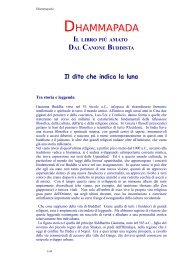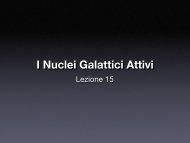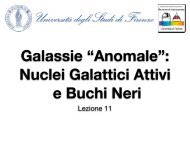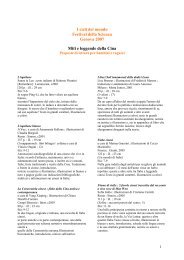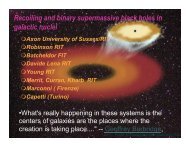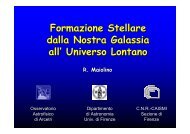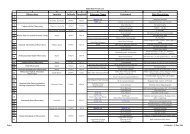Studio delle prestazioni di un sistema a fosfori per mammografia ...
Studio delle prestazioni di un sistema a fosfori per mammografia ...
Studio delle prestazioni di un sistema a fosfori per mammografia ...
You also want an ePaper? Increase the reach of your titles
YUMPU automatically turns print PDFs into web optimized ePapers that Google loves.
its <strong>di</strong>rection is a constant f<strong>un</strong>ction covering all the spatial frequency range. The image of a slit<br />
is the so-called Line Spread F<strong>un</strong>ction.<br />
2.2.1 Digital MTF<br />
In a <strong>di</strong>gital system, the sampling procedure usually leads to complication due to <strong>un</strong>dersampling<br />
in the MTF analysis since, as will be explained later, the system response depends on the spatial<br />
frequency content of the images being evaluated. Undersampling in <strong>di</strong>gital systems occurs<br />
when the image is not sampled finely enough to record all spatial frequencies without aliasing.<br />
Undersampling is almost always present to some degree in any real <strong>di</strong>gital imaging device,<br />
and not only makes the physical measurement of MTF more <strong>di</strong>fficult but it also complicates the<br />
pro<strong>per</strong> <strong>un</strong>derstan<strong>di</strong>ng and interpretation of these quantitative measures. The main complications<br />
are related to the fact that, when applying classical analysis to <strong>un</strong>dersampled <strong>di</strong>gital systems,<br />
the MTF do not behave as transfer amplitude of a single sinusoid and the response of a <strong>di</strong>gital<br />
system to a delta f<strong>un</strong>ction is not spatially invariant. There are two main elements <strong>di</strong>stinguishing<br />
the MTF of a <strong>di</strong>gital system from that of an analog system: replication of FTs in frequency<br />
space and the overlapping of FT segments from aliasing 1 when the system is <strong>un</strong>dersampled.<br />
While replication and aliasing overlap are certainly related, they are <strong>di</strong>fferent in the effects they<br />
have on the interpretation of MTF in <strong>un</strong>dersampled <strong>di</strong>gital systems. The replication of FTs<br />
is a result of the infinite sum of sinusoids required to produce a signal comprised of a string<br />
of infinitely sharp delta f<strong>un</strong>ction, i.e. from multiplying the original f<strong>un</strong>ction by the sampling<br />
f<strong>un</strong>ction � ¡ ÁÁÁ Ü� � . The overlap of these FT replications, on the other hand, is the result of<br />
<strong>un</strong>dersampling, by which aliasing causes sampled frequencies above the Nyquist frequency to<br />
contaminate their co<strong>un</strong>terpart frequencies below the Nyquist frequency (see Fig. 2.2).<br />
In order to <strong>un</strong>derstand how these effects reflect quantitatively on the MTF, the terms con-<br />
tributing to the system OTF must be considered. The OTF of a <strong>di</strong>gital system is comprised<br />
of a presampling component and a sampled component. The presampled OTF is the result of<br />
image blurring from geometric considerations (for instance focal spot blurring), analog input<br />
1aliasing is so named because a sampled sinusoid of frequency¡Ù above the Nyquist frequency Ù Æ is identical<br />
in every regard to a sampled sinusoid of frequency ¡Ù below Ù Æ (if at the same phase); thus the higher-frequency<br />
sinusoid takes the alias of the lower frequency.<br />
21





